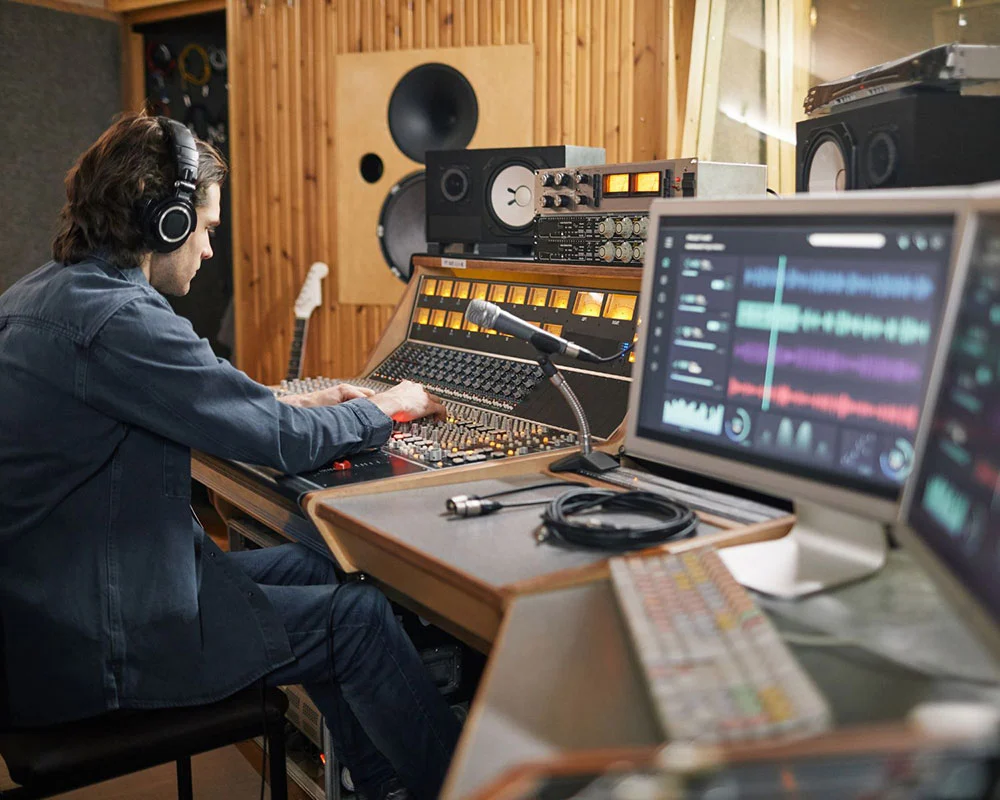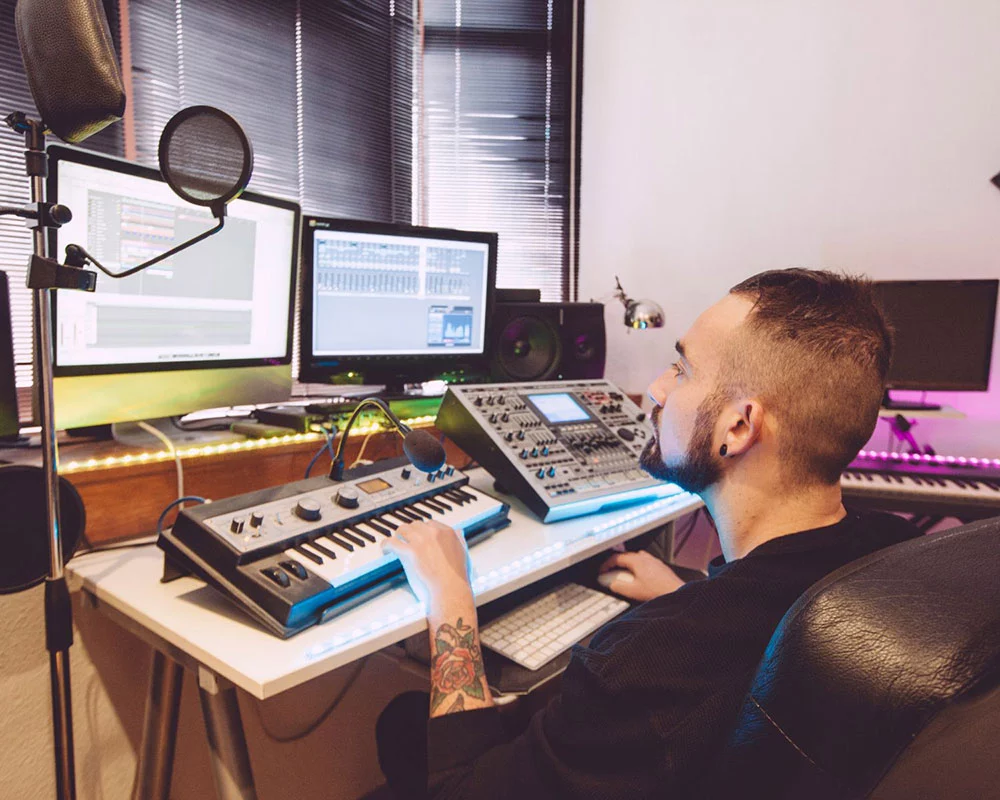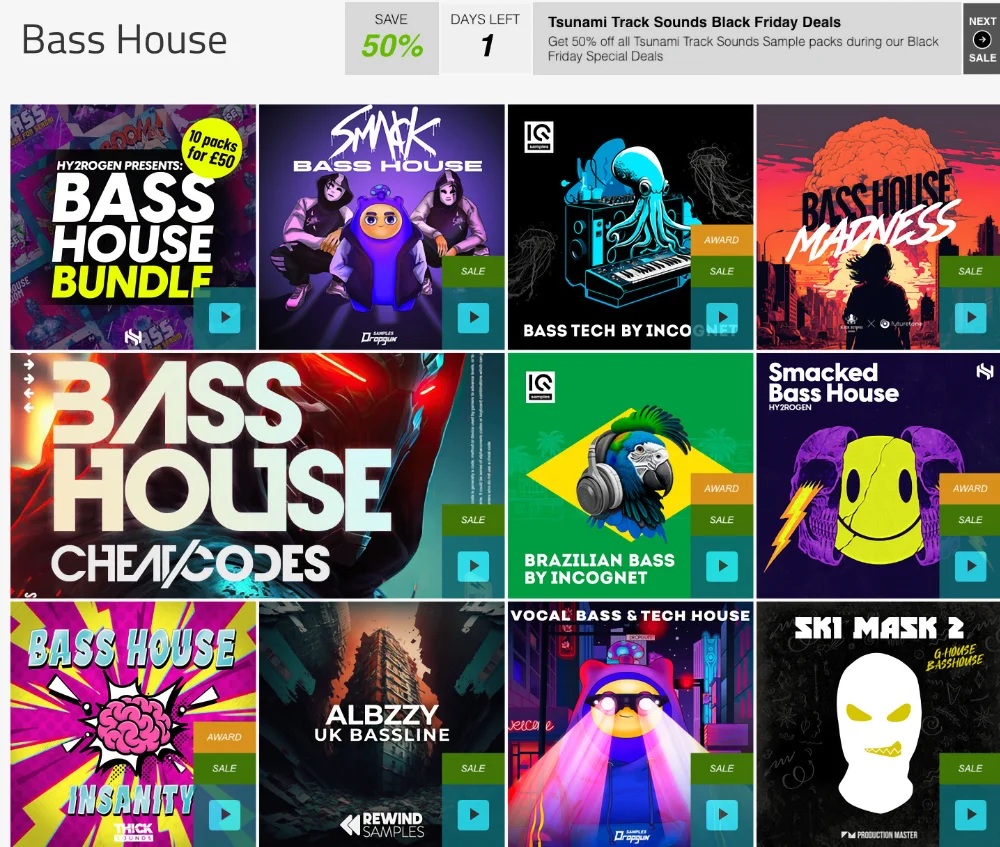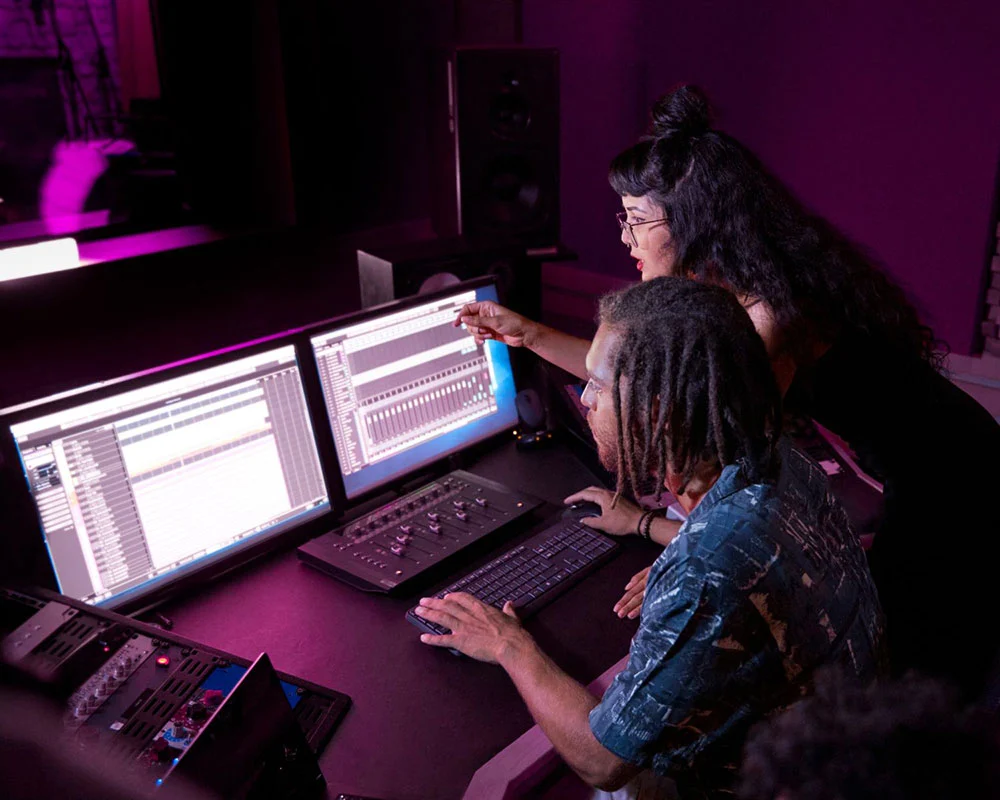Though you might think the market’s too saturated, there’s always room for high-quality, original samples and loops that stand out. You’ve got a unique sound, and there’s a producer out there who needs exactly what you’re offering.
To cash in on your creativity, start by defining your niche and understanding your audience. Then, focus on crafting a professional-grade sample pack that showcases your best work.
You’ll want to choose a platform that aligns with your brand, whether it’s a popular marketplace or your own website. Remember to tag your samples with relevant metadata to ensure they’re easily discoverable.
With consistency and an ear for what’s in demand, you’ll build a reputation that turns your passion for sound into a profitable venture.
If you are looking for sample packs to download, check out the largest collection of free sample packs on the web. Additionally, if you’re using FL Studio Mobile and want to know how to add these loops and samples effectively, you can find a guide here.
Key Takeaways
- Selling sample packs offers new revenue opportunities for musicians.
- Creating a diverse sound kit portfolio attracts a wider customer base.
- Smart marketing tactics, like leveraging social media and forums, can boost sales.
- Pricing packs competitively requires thorough market research.
Introduction to Selling Samples and Loops

You’re entering a booming market where custom sample packs are in high demand, offering a unique opportunity to monetize your creativity.
By crafting and selling your own soundscapes, you can tap into a stream of income that rewards originality and sonic craftsmanship.
Understanding the potential of earning through sample packs is the first step to turning your audio creations into a profitable business.
The Growing Market for Custom Sample Packs
As a musician, you’ll find that the demand for unique and high-quality custom sample packs is on the rise, offering you new revenue opportunities in the digital market. To better understand these key components of music production, you can learn more about the difference between loops and samples here. This burgeoning niche allows you to showcase your production skills and cater to a community of music producers and beatmakers hungry for fresh sounds.
When you sell your loops, you’re not just moving audio files; you’re providing the building blocks for new musical creations.
To effectively sell your sample packs, focus on pristine audio quality and variety. Use platforms like Sellfy to seamlessly promote your sample packs, tapping into robust marketing tools to reach your target audience.
Potential of Earning Through Sample Packs

Diving into the world of selling your own samples and loops, one can discover significant earning potential, turning musical creativity into a sustainable income stream. As a music producer, you’ve got the chance to make money selling sample packs that resonate with a broad audience of fellow creators. But what does it really take to tap into this market successfully?
Let’s break it down:
- Create a diverse sound kit portfolio that caters to various genres and styles.
- Ensure your samples are royalty-free to attract a wider customer base.
- Price your packs competitively after thorough market research.
- Use smart marketing tactics to sell your samples, leveraging social media and music production forums.
With dedication and savvy moves, your sounds could be the next big hit in studios around the world.
Creating Your Unique Sample Pack

To stand out in a crowded market, you’ll want to infuse your sample pack with a distinctive sonic signature that resonates with your target audience.
Be meticulous in organizing and labeling your samples, ensuring they’re easy to navigate and compatible with industry standards.
Lastly, safeguard your work by thoroughly understanding and adhering to copyright laws, confirming that every beat and melody is unmistakably your creation.
Crafting a Unique “Sound” for Your Sample Pack
Crafting a unique sound for your sample pack is essential, as it’ll set you apart from the competition and give your work a signature appeal. To ensure your sound design shines, focus on these key elements:
- Dive Deep into Sound Design: Experiment with various synthesis techniques and tweak synth presets to forge sounds that are unmistakably yours.
- Prioritize Sound Quality: Invest in high-end plugins and equipment to ensure each sample resonates with crystal-clear fidelity.
- Embrace Your Creative Identity: Infuse your personal music influences and experiences into the creation process for a unique sound that resonates with your brand.
- Master the Details: Pay meticulous attention to mixing and mastering, ensuring your samples are polished and versatile for any production.
Organizing and Formatting Your Samples for Sale
Once you’ve crafted your unique sound, it’s crucial to organize and format your samples in a user-friendly way that’ll make them irresistible to producers.
Begin by ensuring your digital products are meticulously categorized, with loops and samples clearly labeled with key and tempo information. This attention to detail not only showcases your industry-savviness but also streamlines the creative process for your customers.
Your sample pack should come with a coherent license agreement, detailing usage rights plainly. Remember, clarity is king.
Include high-resolution artwork to catch eyes, and couple it with a polished audio demo that flaunts the potential of your sounds.
Legal Considerations: Ensuring Originality and Copyright

As you venture into the world of selling your samples and loops, it’s essential to ensure that every sound you create is original and doesn’t violate any copyright laws. Crafting a distinctive sample library that resonates within the music production community hinges on adhering to these legal considerations:
- Draft a Clear EULA: Define usage rights and restrictions to prevent misuse of your work.
- Ensure Absolute Originality: Avoid sampling copyrighted material unless you’ve obtained clearance.
- Seek Legal Counsel: Consider consulting with a legal expert to fortify your sample pack’s copyright.
- Educate Your Users: Provide clear guidelines on how they can legally use your samples in their projects.
Embrace these steps to confidently sell samples that are as legally sound as they’re creatively inspiring.
Designing Your Sample Pack
As you craft your sample pack, remember that visuals can be just as compelling as the sounds within. Your cover art needs to capture the essence of your audio, enticing producers with a creative and polished design that hints at the sonic treasures inside.
Alongside this, penning a clear and comprehensive EULA ensures your samples are used correctly, protecting your work while empowering others to innovate with it.
Creating Engaging Cover Art and Demo Tracks

Kick off your sample pack’s success by crafting eye-catching cover art and a compelling demo track that’ll grab buyers’ attention. As a producer or beatmaker, you know the power of first impressions. Your cover art should resonate with your unique sound, while your audio demo acts as a sonic handshake with potential clients.
Here’s how to make your professional sample pack stand out:
- Design High-Quality Cover Art: Use tools like Adobe Photoshop, Canva, and AI tools like Midjourney to create an unforgettable visual first impression.
- Craft an Engaging Audio Demo: Mix and master a showcase track that encapsulates the essence of your samples.
- Convey the Pack’s Mood: Your cover and demo should reflect the genre and vibe you’re selling.
- Be Detail-Oriented: Include key and tempo tags, ensuring your pack’s usability for your audience.
Writing an Effective End-User License Agreement (EULA)
Once you’ve captivated buyers with your cover art and audio demo, it’s crucial to secure your work with a well-crafted End-User License Agreement (EULA). Drafting this document is a pivotal step when you’re ready to sell sample packs or sound kits through your online store. The EULA ensures that your customers understand their rights and your expectations, keeping your intellectual property safe.
Here’s a table to help you conceptualize the key components:
| Aspect | Details | Importance |
|---|---|---|
| Usage Rights | What buyers can and can’t do with the samples | Protects IP |
| Restrictions | Prohibit resale/transfer | Maintains value |
| Licensing Terms | Grant of use, not ownership | Clarifies use |
| Legal Clauses | Remedies for misuse, jurisdiction | Enforces EULA |
Choosing the Right Platform to Sell Your Samples

You’re ready to monetize your beats, but navigating the sea of platforms like Splice and Roqstar can be tricky. Weighing their pros and cons is critical for your success.
Crafting your own digital storefront stands as a viable option. However, leveraging established marketplaces might offer immediate exposure and convenience.
Keep in mind, versatile platforms such as Fiverr and Sellfy require a different strategic approach. Especially when tapping into their diverse, global user bases.
Setting Up Your Own Website vs. Using Marketplaces

In choosing where to sell your samples and loops, you’ll need to decide between the autonomy of running your own website and the convenience of using established marketplaces.
If you’re itching for full control and keeping all profits, start selling sound kits on your bespoke site. But remember, it demands tech-savvy skills and marketing prowess to attract traffic.
Alternatively, using marketplaces like Loopmasters or Sellfy can kickstart your venture swiftly. Sellfy stands out with its marketing features, including discounts and email outreach, essential for growing your customer base. Loopmasters offers a vast network but may not equip you with the same promotional tools.
Weigh the pros like wide exposure against cons such as sharing revenue to find the perfect platform for your sample packs online.
Special Considerations for Platforms like Fiverr and Sellfy
Evaluate the unique benefits and constraints of platforms like Fiverr and Sellfy to determine where your samples and loops will thrive. If you’re thinking about selling your audio creations, consider these key points:
- Fiverr: Ideal if you want to sell samples as a service, with a wide-reaching customer base.
- Sellfy: Offers more control and direct sales, perfect for those seeking ownership without intermediaries.
- Customer Base: Platforms like Soundcloud could attract a different audience, diversify your exposure.
- Flexibility: While Fiverr may provide volume, Sellfy allows for higher pricing and customization.
Your choice should align with not just where you’ll reach buyers, but also how you want to manage your sample-selling business.
Be strategic, and your sounds could be the next big hit.
18 Best Marketplaces to Sell Your Sample Packs

Here are the top marketplaces for selling your sample packs. The links for these marketplaces link to the contact pages and sample pack submission forms to help save you time.
Pricing Strategies for Your Sample Packs

Setting the right price for your sample packs is key. You’ll want to balance affordability and perceived value, ensuring you’re competitive yet profitable.
Toss in a few freebies or limited-time discounts to spark interest and show off the quality of your work.
Keep a keen eye on the market’s pulse. Regularly tweaking your prices to align with industry standards and customer expectations.
Determining the Right Price for Your Packs
To determine the right price for your sample packs, you’ll need to conduct thorough market research to understand the going rates for similar products. Here’s a strategic approach to pricing your packs competitively while maximizing your potential to make money selling production music:
- Analyze Competitors: Examine the prices of sample packs from both industry leaders and niche creators.
- Value Proposition: Set prices that reflect the quality, uniqueness, and potential utility of your samples in production music.
- Tiered Offerings: Offer different pricing tiers or bundle deals to cater to various customer needs and budgets.
- Adjust Regularly: Keep an eye on market trends and customer feedback to tweak prices as needed.
Offering Freebies and Discounts to Attract Customers

As you develop your pricing strategy for selling samples and loops, consider incorporating freebies and discounts to entice new customers and reward loyal ones.
Offering a selection of freebies can serve as a powerful incentive, giving producers a taste of your drum kits and sample packs. Think of these as appetizers that whet the appetite for the main course—your full premium packs.
Crafting tiered discounts can also attract customers operating at different budget levels. For instance, bundle deals where purchasing multiple packs triggers a discount can encourage more extensive investment.
Marketing Your Sample Packs Effectively

To make your sample packs the go-to for producers, there are several strategies you can implement:
- Leverage your social media presence: Curate engaging content that highlights your unique sounds. This could include snippets of your sample packs, behind-the-scenes footage of your production process, or tutorials showcasing how to use your samples effectively. Consistently engage with your followers, respond to comments, and actively participate in relevant producer communities to build a loyal audience.
- Implement savvy traffic-driving strategies: Optimize your online store for search engines by using relevant keywords in your product descriptions, titles, and tags. This will help potential buyers find your sample packs when searching for specific sounds or genres. Additionally, consider running targeted ads on platforms like Facebook, Instagram, or YouTube to reach producers who may be interested in your offerings. Craft ad campaigns that resonate with your audience and clearly communicate the value of your sample packs.
- Partner with well-known influencers and fellow producers: Collaborating with influencers who have a large following in the music production community can significantly boost your brand’s visibility. Reach out to popular YouTubers, bloggers, or producers and offer them free access to your sample packs in exchange for a review or feature on their platforms. By associating your brand with respected individuals in the industry, you can build credibility and gain access to a broader network of potential buyers.
These strategies, when implemented effectively, can help you establish your sample packs as the go-to choice for producers.
Utilizing Social Media for Promotion

Leveraging social media, you’ll significantly boost your sample pack’s visibility and attract a dedicated audience of music producers. To harness the power of these platforms, consider these steps:
- Create Captivating Content: Produce videos that not only showcase your samples but also tell a story. Engage your audience with the creative process behind your packs, and drop audio previews that spark inspiration.
- Foster Community Engagement: Actively participate in music community discussions. Your insightful comments can draw attention and build trust within the independent music scene.
- Leverage Influencer Collaborations: Partner with established music production influencers to tap into their follower base and gain credibility.
- Track Trends and Analytics: Use social media insights to understand what content resonates with your audience and tailor your promotion strategy accordingly.
Strategies for Generating Traffic to Your Store
Building on your social media momentum, you’ll need a targeted marketing strategy to drive potential customers to your sample store with precision. To start selling to beatmakers looking for fresh sounds, it’s crucial to market your sample packs right.
First, ensure you upload your sample collections with clear, enticing descriptions that highlight the unique qualities of your creations. When you make a sample pack, think like a producer—what sounds would ignite their creativity?
Craft engaging content that showcases your samples in action, offering a taste of the magic producers can weave with your sounds. Consider using email marketing to send out sample pack samplers, enticing potential buyers with a glimpse of the quality you offer.
With these focused strategies, you’ll turn your beats into a sought-after commodity.
Collaborating with Influencers and Other Producers

By partnering with influencers and fellow music producers, you’ll amplify your sample packs’ visibility and appeal to a broader audience. Your trap sample packs or hip-hop loops can become the popular sample choice when you get the endorsement of those who’ve already made their mark, perhaps even those signed to Mafia-like labels or collectives. To maximize the impact:
- Identify influencers who resonate with your genre and audience.
- Offer exclusive previews or free packs in exchange for their promotion.
- Collaborate on content that showcases the versatility and quality of your samples.
- Encourage influencers to share their creative process using your samples, adding authenticity to the promotion.
This strategy won’t only widen your reach but also associate your brand with trusted figures in the industry.
The Role of Customer Feedback and FAQs
Listening to your customers’ voices gives you an insider’s edge to refine your sample packs, ensuring they hit just the right note.
By addressing common questions in a comprehensive FAQ, you’ll cut down on support tickets and empower producers with instant guidance.
Use the feedback loop as your secret weapon to continually evolve your offerings, staying ahead of the sonic curve in this fast-paced market.
Addressing Common Customer Questions
To effectively sell your samples and loops, it’s crucial that you gather and address customer feedback, ensuring your products meet the needs and expectations of your audience. Here’s how you can be proactive:
- Create a Robust FAQ Section: Include answers to common queries about file formats, licensing, and whether customers can purchase sounds individually or if they’re tethered to a subscription-based model.
- Sample Magic Through Feedback: Use reviews to sprinkle a bit of sample magic, refining your offerings based on what’s resonating with your users.
- Pricing Strategy Insights: Analyze customer opinions to find the sweet spot in pricing—neither undervaluing your work nor outpricing your market.
- Responsive Support: Ensure you’re selling not just sounds, but reliability; quick, helpful responses to problems can turn a one-time buyer into a loyal client.
Using Feedback to Improve and Expand Your Product Line

In light of your customer’s feedback, you’ll find invaluable insights that can significantly refine and expand the range of your sample and loop offerings. Engage with your audience to decipher which presets resonate and which need finessing.
Sound designers, take note: the demand for fresh, innovative sounds is ceaseless. Use critiques to shape your next kits and sample packs, ensuring they hit the mark. Have trap samples lost their luster? Incorporate the latest trends into new samples, always staying ahead of the curve.
Advanced Tips for Successful Sample Pack Selling
To stay ahead in the sample pack market, you’ve got to keep a pulse on emerging trends and evolving customer tastes. Regularly refreshing your library with innovative sounds ensures your offerings don’t grow stale.
Analyzing Market Trends and Customer Preferences
You’ll need to stay on top of the latest market trends and customer preferences to ensure your sample packs remain in high demand. Dive deep into the sonic landscape and discover what’s resonating with producers and creators.
Here’s how:
- Track the Pulse of Popularity: Keep an eye on charts and forums for what genres are peaking. Are retro synths making a comeback? Is there a surge in lo-fi loop requests?
- Listen to Feedback: Analyze reviews and user comments for insights into what specific sounds entice your audience.
- Sales Data Savvy: Scrutinize which of your WAVs and MIDIs are bestsellers, indicating a trend.
- Innovate Intuitively: Fuse trending elements with fresh creativity to offer unique and sought-after sounds.
Continuously Updating and Adding to Your Sample Packs

Keeping your sample packs up-to-date requires that you’re not just tracking trends, but also proactively adding fresh sounds to maintain your edge in the market. If you want to sell your creations as a great way to make money, having full control over your content is key. Continuously updating and adding to your sample packs isn’t just a smart strategy—it’s essential for keeping your offerings among the best sellers.
| Update | Emotion | Impact |
|---|---|---|
| Fresh Loops | Excitement | Drives Creativity |
| Diverse Samples | Curiosity | Expands Reach |
| Bug Fixes | Relief | Builds Trust |
| New Genres | Surprise | Captures Interest |
| Customer Ideas | Inclusion | Fosters Loyalty |
Stay ahead by anticipating what’s next and incorporating those sounds that producers didn’t even know they needed until you provided them.
Challenges and Solutions in Selling Sample Packs
As you step into the realm of selling your own sample packs, you’ll encounter unique challenges. From ensuring pristine audio quality to setting the right prices, there are various aspects to consider.
You’ve got to wear your mix engineer hat to polish your samples to perfection. This involves fine-tuning the sounds, adjusting levels, and ensuring they are of the highest quality possible.
Additionally, you need to put on your market analyst glasses to price your sample packs competitively. Researching the market, analyzing competitors’ pricing strategies, and understanding the value of your own offerings are crucial steps in this process.
However, it’s not just about the quality of your samples and the competitive pricing. Clear usage instructions are essential for your customers. Providing detailed information on how to use the samples can greatly enhance their experience and increase the likelihood of repeat purchases.
Common Challenges Faced by Sellers

Navigate the complexities of selling your own samples and loops by understanding the common challenges and implementing strategic solutions. With an industry-savvy approach, you’ll tackle hurdles head-on, ensuring your audio files resonate with producers and beat-makers alike.
Here’s how you can overcome common obstacles:
- Organization: Just as Adobe Photoshop requires meticulous layer management, sort your samples into subfolders—think FL Studio’s tidy browser.
- Licensing Clarity: Provide explicit documentation, much like Airbit’s license agreements, to avoid legal gray areas.
- Pricing Strategy: Choosing the best price point involves market research and customer feedback, balancing value with demand.
- Marketing Savvy: Harness social media to showcase your sounds, creating content as engaging as a drop in an EDM banger.
Embrace these solutions and watch your sample pack sales soar.
Solutions and Best Practices for Overcoming These Challenges
To overcome the hurdles in selling your samples and loops, you’ll need to implement best practices that resonate with your audience and ensure a seamless transaction.
For those crafting house and techno beats, serum presets can be your golden ticket, giving users the synths and sounds that define the genre.
To get ahead, I recommend you start by offering clear usage rights, avoiding any post-purchase confusion.
Platforms like Loopcloud can be invaluable allies, providing the exposure and infrastructure needed for your products.
Make sure to provide demos; they’re everything you need to know in a nutshell, showcasing the potential uses of your samples.
Building a Sustainable Business with Your Samples and Loops

You’ll solidify your reputation and generate ongoing revenue by selling high-quality, well-organized sample packs that cater to the needs of producers and artists. Here’s how you can build a sustainable business:
- Market Research: Understand what you’re offering is in demand by keeping up with music trends.
- Brand Development: If you’re just starting, it’s a great idea to create a brand that resonates with your target audience.
- Customer Engagement: Learn how to make money by actively engaging with customers for feedback and building relationships.
- Consistent Quality: Ensure you’re ready to deliver consistent quality that keeps producers coming back for more.
Frequently Asked Questions
How Do I Sell Sample Loops?
To sell sample loops, create unique, high-quality sounds, categorize them effectively, and showcase them on platforms like Sellfy, leveraging social media for promotion. Ensure clear usage instructions and professional presentation to attract buyers.
How Much Does Splice Pay?
You’ll find Splice pays variably; producers can earn a full-time income based on the royalties from their popular and quality-driven samples that align with Splice’s stringent Quality Principles.
Do People Buy Sample Packs?
Yes, people do buy sample packs. They’re hot commodities in the bustling music production industry, offering fresh sounds that fuel creativity and streamline workflows for producers and artists alike.
Are Samples Copyright Free?
No, samples aren’t copyright free. You must check their license agreement for usage terms and whether you need to pay royalties for commercial use to avoid legal issues.
How can one create unique trap music samples and loops for selling?
One can use digital audio workstations (DAWs) like FL Studio, Ableton Live, or Logic Pro X to create unique trap music samples and loops. It is important to understand the fundamental elements of Trap music such as 808 kick drums, snare rolls, hi-hat patterns etc.
What are some effective strategies to sell your trap music samples and loops on Instagram?
To effectively sell your samples on Instagram: Build a strong online presence by consistently posting content related to your music; Use appropriate hashtags to reach potential buyers; Run paid promotions targeting musicians who might be interested in your genre; Collaborate with other producers or influencers within the same niche.
What role does copyright play when selling my own trap music samples and loops?
Copyright plays a significant role in protecting your work from unauthorized use. You automatically own the copyright of any original sample you create. However, registering it formally provides legal evidence of your ownership which can be beneficial if disputes arise.
How can I price my trap music samples and loops effectively?
Pricing depends on several factors including the quality of your sampleloop, its uniqueness, demand in the market etc. Research what similar products are being sold for and consider offering bundles for higher value.
Why should I consider getting insurance when selling my own trap music samples and loops?
If youre running a business from home producing and selling these materials, having insurance will protect you against risks such as theft or damage to equipment used in creating these sounds. Some insurers also offer coverage for copyright infringement claims which could potentially arise in this line of work.




